When summer approaches, we all crave some refreshing like pineapple. But, can our lovely guinea pigs enjoy this delicious fruit, and is it safe for guinea pigs? We all already know that there are some foods that guinea pigs can’t eat, so let’s find out what is the case with pineapple.
Can guinea pigs eat pineapple? Guinea pigs can eat pineapple, but only occasionally. This fruit contains a lot of sugar, so try to feed them only as a treat and not as regular food due to possible stomach problems. However, there is also a huge amount of vitamin C in pineapple, which is very beneficial for guinea pigs.
It is awesome news that guinea pigs can eat pineapple, even if just rarely as a treat or in small amounts. This fruit has many health benefits, but also some risks along the way.
We will explain everything about pineapple and guinea pigs in the following sections below. Let’s begin!
Table of Content
Is Pineapple Good for Guinea Pigs? | Health Benefits
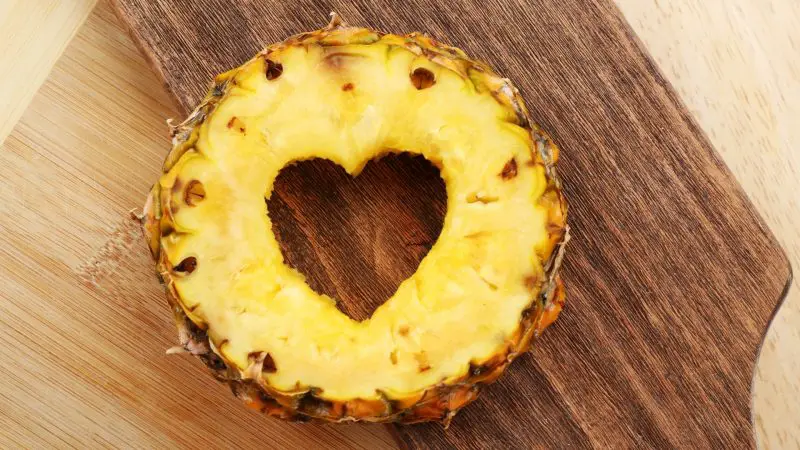
The following are some of the most relevant health benefits pineapples can offer to guinea pigs:
Healthy Weight
Considering that pineapple is lower in fat and calories than other sweet fruits, you won’t need to worry about the guinea pig’s weight.
This means that pineapple is not a fattening fruit. Still, feed guinea pigs pineapple only in small amounts, and they won’t get fat or chubby.
Healthy Cardiovascular System
Pineapple contains magnesium, which will keep the heart muscle strong. Also, thiamin, known as the B1 vitamin, keeps the nerves healthy along with other muscles and the heart.
Scurvy Prevention
Guinea pigs cannot produce vitamin C naturally, so they must get it from food or other supplements. The good thing is that pineapple is very rich in vitamin C. Without vitamin C guinea pigs can get scurvy, a fatal disease that starts manifesting itself with a rough coat, loss of appetite, diarrhea, weight loss, internal bleeding, and weakness.
Healthy Blood and Blood Cells
There are many vitamins and minerals in pineapple that will help with creating blood cells. One of them is vitamin K that will contribute to fast blood clotting. In case of injuries, when there is blood loss, this will be crucial. Vitamin B6 and iron can prevent anemia. Vitamin B6 boosts serotonin, the hormone of happiness, reduces anxiety, and helps with better sleep.
Antioxidants
The manganese in the pineapple is a very strong antioxidant and will keep the immune system strong to fight off most diseases. Mainly, it will keep the health in good shape because it fights free radicals which are able to cause different illnesses, early aging, and many other problems.
Healthy Muscles
Magnesium removes cramps and keeps the muscle tissues strong. Also, this mineral prevents diabetes, migraines, and anxiety too.
Nutrition Facts of Pineapple for Guinea Pigs
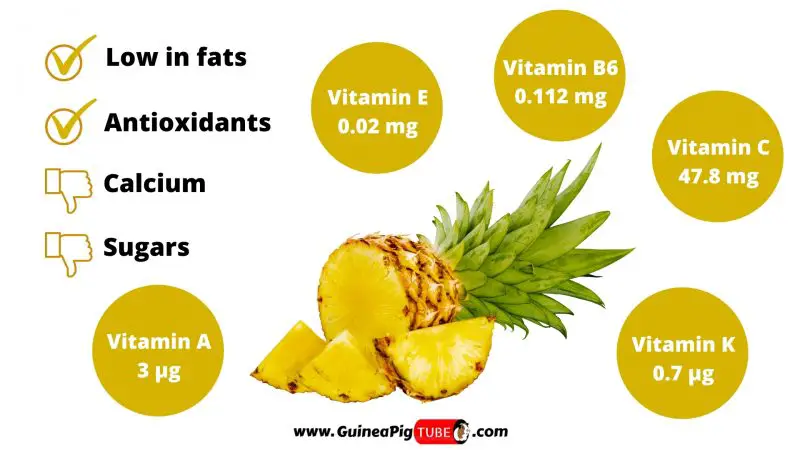
Here are the nutrition information for raw pineapple, 100 g (3 oz):
- Energy – 50 kcal
- Protein – 0.54 g
- Total lipid (fat) – 0.12 g
- Carbs – 13.12 g
- Dietary fiber – 1.4 g
- Sugars – 9.85 g
- Calcium – 13 mg
- Iron – 0.29 mg
- Magnesium – 12 mg
- Phosphorus – 8 mg
- Potassium – 109 mg
- Sodium – 1 mg
- Zinc – 0.12 mg
- Copper – 0.11 mg
- Selenium – 0.1 µg
- Vitamin C – 47.8 mg
- Vitamin B-6 – 0.112 mg
- Vitamin A – 3 µg
- Vitamin E – 0.02 mg
- Vitamin K – 0.7 µg
- Thiamin – 0.079 mg
- Riboflavin – 0.032 mg
- Niacin – 0.5 mg
- Folates – 18 µg
- Carotene, beta – 35 µg
Risks to Consider When Feeding Pineapple to Guinea Pigs
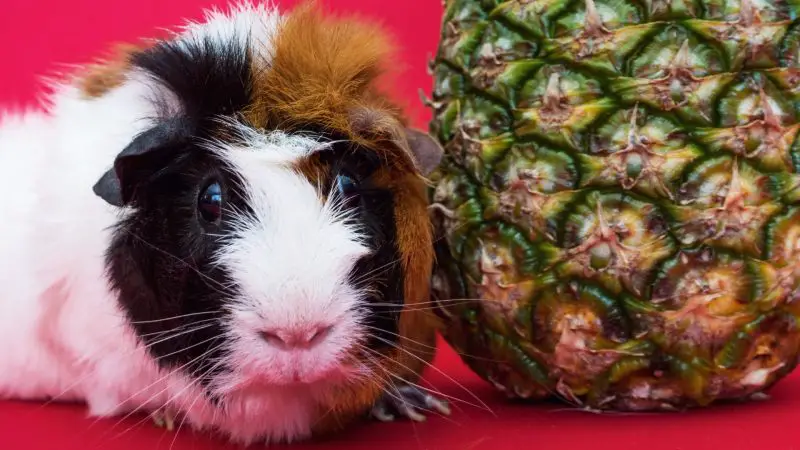
As beneficial as pineapple is to guinea pigs, it also poses certain health risks to them. Some of these risks are as follows:
Urinary Problems
The calcium in the pineapple can cause urinary problems for your guinea pigs. This mineral is crucial for forming strong bones, but only in the early stages of growth and development (baby guinea pigs).
If the guinea pig is fully grown, this mineral will damage its urinary tract and create bladder or kidney stones. Other risks are blood in the urine, pain during urination, or infections in the urinary tract.
Digestion Problems
This fruit is very sugary, and this is definitely not good for guinea pigs. This is because the sugar in the pineapple can cause pain during digestion and cause diarrhea. The guinea pigs don’t digest sugars well, so keep this in mind when giving new foods to them.
Allergies
There is an enzyme called bromelain in pineapples. This enzyme is most present in the stem and leaves of pineapples. Bromelain has many health benefits, but in large amounts, it has some side effects.
Some guinea pigs can be allergic to pineapples, and that usually happens due to bromelain. Some of the pineapple’s allergy symptoms are upset stomach, diarrhea, an increased heart rate, difficulties in breathing, vomiting, and so on.
Serving Size and Frequency of Pineapples for Guinea Pigs
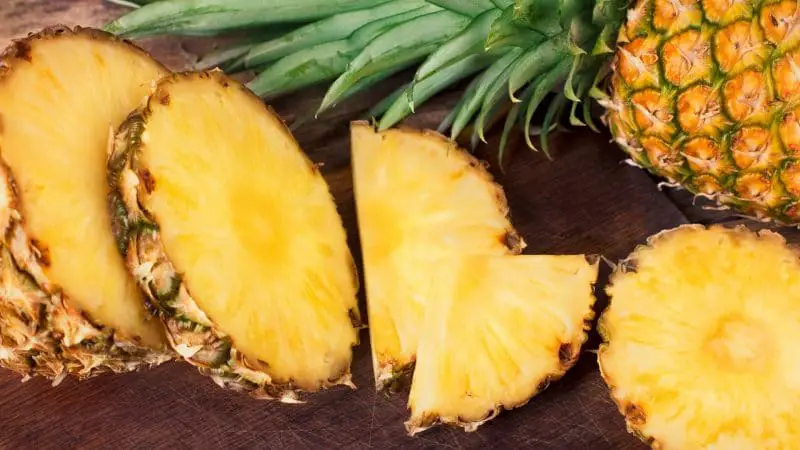
Can Guinea Pigs Have Pineapple Every Day?
Guinea pigs can’t eat pineapple every day due to larger amounts of sugar, which can be very harmful to their stomach and digestion.
Pineapple or any other fruit needs to be given to guinea pigs only occasionally as a treat. You can feed pineapple to them one or two times per week.
How Much Pineapple Can Guinea Pigs Eat?
Guinea pigs shouldn’t eat pineapple in large serving sizes. Guinea pigs are tiny animals with a sensitive digestive system, and giving them pineapples in large amounts can lead to serious stomach problems.
You can feed them only two to three small pieces of pineapple at once. Everything above that limit can cause serious problems. So, you need to be careful and combine pineapples with hay, water, and other fruits and vegetables.
Do Guinea Pigs Like Pineapple?
Most of the guinea pigs like pineapple, and they really enjoy eating this sweet fruit. There is a possibility that some of your guinea pigs will not like to eat pineapple.
That’s completely normal because they have their own taste preferences, just like us humans.
Usually, pineapple is a very delicious and a loved treat for guinea pigs. In general, guinea pigs enjoy eating fruits, such as apples, nectarines, melons, mango, kiwi, blueberries, watermelon, strawberries, and many others.
Can Baby Guinea Pigs Eat Pineapple?
Baby guinea pigs shouldn’t eat pineapple because, during that period, they need a special diet. That special diet contains only the mother’s milk, alfalfa hay, and water. Alfalfa hay is important due to its calcium content, which is beneficial for guinea pigs’ growth. You can later slowly introduce them to some fruit and vegetables after a few weeks. Be sure to give them at first only a tiny piece of pineapple.
More Information About Guinea Pigs and Pineapple
Can Guinea Pigs Eat Fresh Pineapple?
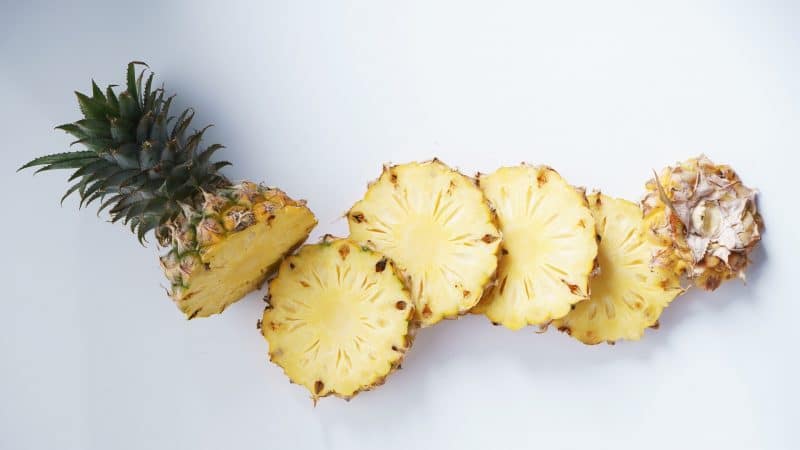
Guinea pigs can eat fresh pineapple, and that’s the only way you can feed this sweet fruit to them. Never feed guinea pigs with stale or processed pineapple. They have a very sensitive digestive system, so stale or processed food can be harmful to their stomach.
Also, be sure to give them only ripe pineapple because unripe pineapple may be toxic to guinea pigs. Eating it can cause diarrhea and throat irritation.
Can Guinea Pigs Eat Pineapple Skin?
Even considering the fact that pineapple skin is beneficial for humans, guinea pigs shouldn’t eat pineapple skin. The pineapple’s skin isn’t toxic to guinea pigs, but it can present a choking hazard.
This skin is very harsh, and guinea pigs may have difficulties chewing on it as well. Also, pineapple skin can irritate their mouth, so it’s better to feed them just the pineapple flesh.
Can Guinea Pigs Eat Pineapple Leaves / Pineapple Tops?
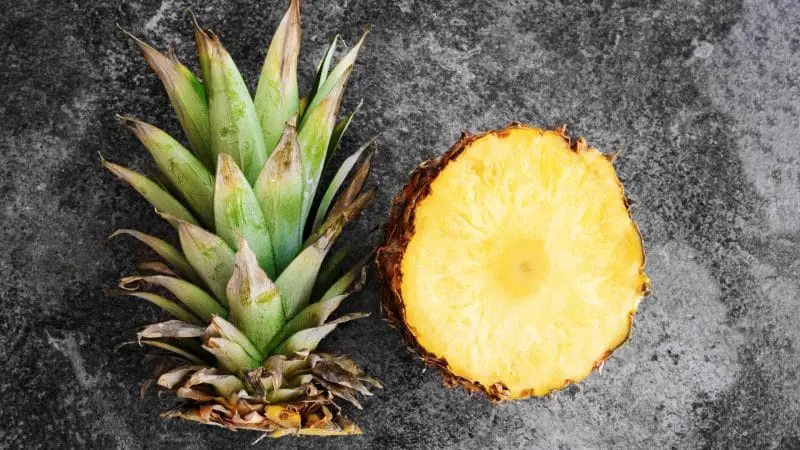
Guinea pigs shouldn’t eat pineapple leaves or pineapple tops. As we’ve already mentioned above, pineapple leaves and stems especially can have toxic effects on guinea pigs.
This is because of the enzyme bromelain, to which they may be allergic.
As we already know, guinea pigs may be allergic to a certain food, so it’s better to avoid feeding pineapple leaves to them. Also, if eaten in huge amounts, pineapple tops or, as people like to call them, pineapple crown can cause diarrhea, vomiting, or irritation of the mouth.
There are other leaves that you can introduce to your guinea pig’s diet, such as apple tree leaves.
Can Guinea Pigs Eat Pineapple Core?
Theoretically, guinea pigs can eat pineapple core because pineapple core has many nutrients including vitamin C, just like the rest of the pineapple. But, pineapple core doesn’t taste as good as the flesh.
It’s very hard in texture and less sweet. Guinea pigs may not like to eat the core.
Moreover, you need to have in mind the bromelain enzyme is especially high in the pineapple core. It may cause diarrhea, vomiting, and other symptoms we mentioned above, this is why we suggested not to feed guinea pigs with pineapple core.
Are Pineapple Stems Poisonous to Guinea Pigs?
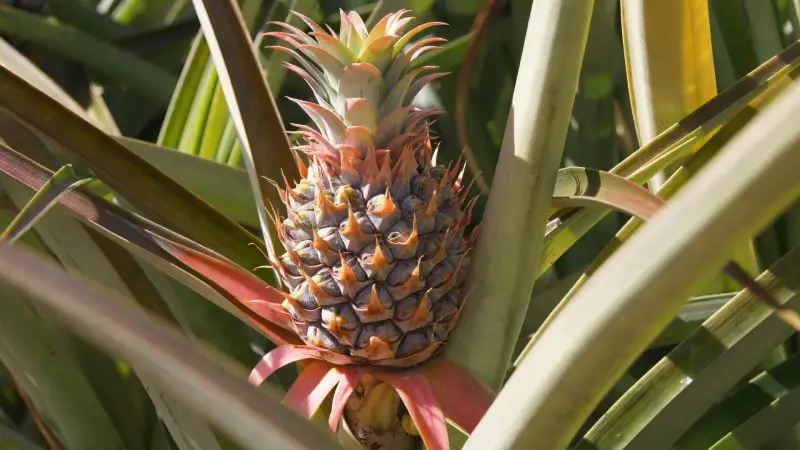
Pineapple stems may be poisonous to guinea pigs if they are allergic to the enzyme bromelain, which is also highly concentrated in pineapple stems. Also, too many stems may be harmful to their stomach and cause serious pain, diarrhea, and vomiting.
It’s better to avoid pineapple stems as food for guinea pigs because they can irritate their throat as well. There are many other greens that you can feed them.
Can Guinea Pigs Eat Dried Pineapple?
Guinea pigs shouldn’t eat dried pineapple because it isn’t a healthy option for them. Dried pineapple contains more sugar, calories, calcium, and less vitamin C.
Dried pineapple is bad for guinea pigs’ health, and they need to eat only fresh and ripe fruits. Never feed them any dried or processed fruits and vegetables, such as dried bananas or dried apricots.
Can Guinea Pigs Eat Canned Pineapple?
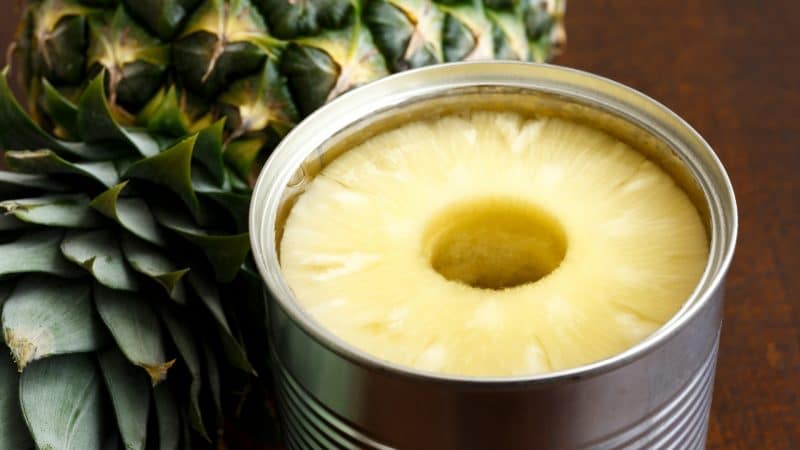
Guinea pigs can’t eat canned pineapple. Usually, every canned fruit is full of added sugar and chemicals needed for processing.
Just imagine the tummy pains the guinea pigs would have if it ingests loads of sugar and processed pineapple fruit from a can.
Canned pineapple contains more sugar, calories, and calcium, but fewer vitamins, when compared to raw pineapple.
The same case is with dried pineapple. So, it is not a good idea at all to feed the guinea pig with canned pineapple.
Can Guinea Pigs Drink Pineapple Juice?
Guinea pigs can’t drink pineapple juice that you have bought in the store. Comercial pineapple juices are usually full of sugar and additives, which can be very painful to guinea pigs’ digestion.
The only option is to give them 100% homemade pineapple juice diluted with water and without added sugars. This type of homemade juice is safe to give them but only occasionally.
Can Guinea Pigs Eat Pineapple Sage?
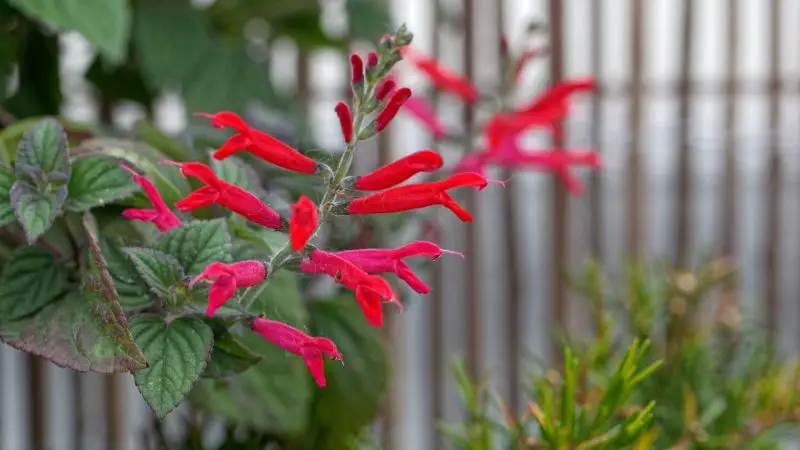
Pineapple sage is a herb with green leaves and red flowers with a sweet and intense tropical pineapple scent. This fragrant plant is from the mint family and is edible for humans.
Pineapple sage has antibacterial and antioxidant properties, and people use it as a medical herb. Guinea pigs can eat pineapple sage but only in small amounts.
You can feed them one or two fresh leaves of pineapple sage. But due to the strong smell and taste, some of them will maybe avoid it.
Can Guinea Pigs Eat Pineapple Weed?
Pineapple weed is another plant that has a strong pineapple smell and sweet, pineapple-like taste.
This plant has yellowish-green flowers that look similar to cultivated chamomile flowers but without white petals. Pineapple weed is also called wild chamomile and is used as a medical herb.
Guinea pigs can eat pineapple weed but only in moderation. Just be sure to give them pineapple weed that is well-washed and only in small amounts.
It is also important to give them this plant with caution because some guinea pigs may be allergic to pineapple weed.
Quick Facts on Pineapple
The following are some interesting facts on pineapple:
- You can easily plant your own pineapple. Plant the pineapple leaves to grow yourself a pineapple plant.
- Chefs use pineapple to soften up meats. The pineapple has the enzyme bromelain that makes meats tender (this enzyme breaks down the proteins).
- The pineapple is fully ripe after 3 years of growth on average.
- The European travelers and explorers named this fruit pineapple because it looked like a “pine cone” up close.
- In Maui, people make wine from this fruit.
- This fruit’s origins are from South America, but most pineapples come from Southeast Asia (Thailand and the Philippines).
- The pineapple was first introduced in Europe by Christopher Columbus back in 1493.
- If you harvest the pineapples while they are still unripe, they won’t ripen later on. The way you bought it, it will stay that way.
- One pineapple plant produces only one pineapple fruit.
- Vinegar can be made out of pineapple as well.

List of Sources
Nutrient Requirements of Laboratory Animals: Fourth Revised Edition
The Effects of Diet on Anatomy, Physiology and Health in the Guinea Pig
